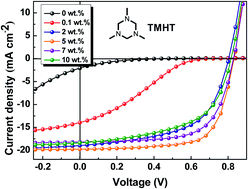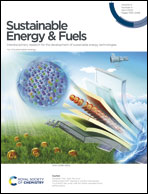N-doping of fullerene using 1,3,5-trimethylhexahydro-1,3,5-triazine as an electron transport layer for nonfullerene organic solar cells†
Abstract
Electron-collecting interfacial layers play an important role in nonfullerene (NF) organic solar cells (OSCs). ZnO and polyethylenimine ethoxylated (PEIE) are the generally used interfacial materials in inverted NF OSCs. However, NF OSCs tend to show poor chemical and photostability in the presence of the two materials. Here, we demonstrate another option that doped fullerene with an n-dopant of 1,3,5-trimethylhexahydro-1,3,5-triazine (TMHT) can be an efficient electron-transport layer (ETL) for efficient NF solar cells. The TMHT doping improves conductivity by three orders of magnitude and shifts the Fermi levels of PCBM by 0.3 eV. As the doping concentration increases, the electron collection properties of the doped layer were significantly enhanced as confirmed by the current density–voltage (J–V) characteristics of the devices. S-kinks in the J–V characteristics gradually disappear and the fill factor increases from 0.13 to 0.69. The devices with a doped PCBM ETL show better photostability under continuous illumination compared with reference devices with a ZnO ETL.



 Please wait while we load your content...
Please wait while we load your content...